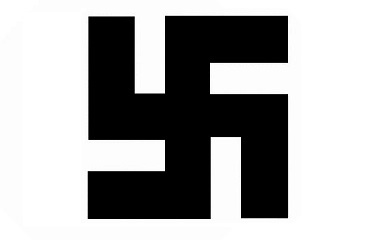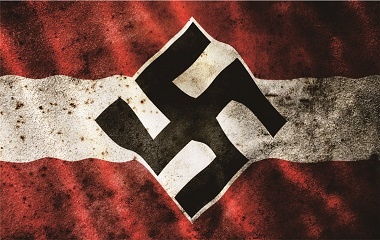If you were to walk the streets of Mumbai or peruse the architecture in Chennai, you’d likely come across an ancient symbol with conflicting meaning in today’s world – the swastika. This symbol has come to represent hatred and the oppression of minority groups in the Western world because of Hitler’s appropriation of the symbol. In the East however, the meaning of the swastika could not be more different.
What is the Swastika?
The swastika is a symbol that is integral to the Hindu religion and has been shared with many other religions and cultures as a result of their interaction with early India. The symbol has been traced back to Hinduism and India as early as 5,000 years ago and has become deeply engrained in their society since then.

The swastika is made up of three Sanskrit roots that give reference to the good luck this symbol is thought to bring. “Su”, meaning ‘good’. “Asti”, meaning ‘exists, there is, or to be.’ And “ka”, meaning ‘make.’ When combined, they roughly translate to ‘making of goodness’ or ‘marker of goodness.’ It is commonly associated with the idea of good fortune and prosperity – so much so that it is commonly found in everyday activities.
Finding a swastika that marks an entrance, doorway, or financial ledge is not uncommon. It is thought that by putting a swastika at the beginning of these things, good fortune and well-being is sure to follow. The swastika can also be found on religious texts. Such is the case with Jainism, whose texts and temples are required to contain the right-handed swastika.
What Religions Can the Swastika Be Found In?
The swastika can be found in cultures as early as Mesopotamia, though it is most notably used by the Hindu religion. With the spread of information however, the swastika came to be a symbol that was respected by many cultures and religions.
Hinduism
Hinduism is one of the main religions that the swastika can be found in. In their religion, the swastika can be found in both the right facing and left facing design, though the right facing swastika is by far the most common. This is likely because the right facing swastika tends to be more so associated with good fortune, while the left facing swastika is associated with the tantric practices of the goddess Kali – a deity known for her protective forces that were known to leave destruction in her wake.
Jainism
The swastika is an integral part of Jainism. In Jainism, the swastika represents the four places in which the soul can be reborn in the cycle of life. These places are thought to be heaven, hell, humanity, and nature (as flora or fauna). These rebirths will eventually lead to the soul finding salvation and becoming omniscient. In the Jain religion, all temples and religious texts must contain the swastika and many ceremonies are started and ended with the sign.
Buddhism
The swastika is also common in Buddhism where it is perceived as a symbol of the Buddha. In Buddhism, the swastika is considered to be a representation of eternal cycling – a theme that can be found in the samsara doctrine. The right facing swastika is the most common form of the symbol in this religion.
Christianity
When the Christians first came in contact with the swastika through means of trade and travel, it was adapted into their religion as ‘the hooked cross.’ Thus, it became another symbol of Christ’s victory over the grave. In fact, some churches in modern day can be found with many swastikas in their design. This practice spans many centuries as evidenced by the painting of the Seven Sacraments by Rogier van der Weyden, in which a priest is depicted wearing a stole with swastikas in the year 1445. This painting shows the frequency with which the symbol was used to represent the cross.

The Church continued using the swastika until World War 2 when the symbol came to represent the Nazi party of Germany. Although the Nazi party was not the first group to use the swastika, they were by far the most influential. Christians were not alone in abandoning the use of the symbol during the Second World War. The hate and terror that came to be associated with the swastika caused many people to change their perspective on the symbol despite the fact that it was misappropriated.
What Do the Lines of the Swastika Represent?
There are several theories as to what the lines on the swastika could possibly represent. Most theories have some sort of tie to the natural world and the forces at work inside it.
One of the most popular theories as to what the lines of the swastika represent is the path of the sun as it rises and sets. The sun is known to rise in the east and begin to travel west (right to left). When the day comes to an end, the sun begins to set and then continues its journey westward (down and then left). Similarly, the lines of the right facing swastika follow the same pattern and suggest that the sun was an integral part in inspiring the design of the swastika.
There are also theories, however, that the swastika may represent the north pole and the rotational movement of the earth around its axis. It is thought that the sun may also have ties to this design, but that any references to the sun were used to support the north pole – not to serve as the main inspiration.
Others seem to think that the swastika may have been created to represent the belief that the cosmos were pulled by four heavenly horses who were known to revolve around a fixed center point in a clockwise rotation.
What is the Difference Between the Right and Left Handed Swastika?
The distinction between the right-handed swastika and the left-handed swastika are very important. Although the two symbols seem to be nearly identical, they carry two very different meanings.
The Right Handed Swastika
The right handed swastika is considered the ‘traditional’ swastika that is known to carry good fortune and well-being to any person or place who bears its symbol. It is thought that the ‘right handed’ direction of the symbol was meant to represent the way in which the sun rose and set. The sun comes up in the east, travels left (to the west), goes down (while setting), and continues to the left (west) until the next cycle.
The right handed swastika is thought to bring good fortune to those who bear its mark. Because the symbol is known to represent good fortune, it is thought that placing this symbol at the start of something (like the beginning of a ledger or the entrance of a home) would bless people with good fortune that would continue to follow them from that point on.
The Left Handed Swastika (Sauvastika)
The left handed swastika is formerly known as the sauvastika and has a meaning that is very different from its right-handed counterpart. The left handed sauvastika was known to symbolize night and the practices attributed with the goddess Kali.
Kali was known to be the vengeful nature of the goddess Durga. Durga is the warrior goddess who is known to be Shiva’s other half. In Hindu mythology, we are told that Kali first appeared when the demons Chanda and Munda attacked the goddess Durga. Devi Durga was so angered by the attack that her face grew a terrible dark shade and Kali appeared out of her forehead. As soon as Kali emerged, she was known to be a fearsome warrior. She was said to have a black complexion, sunken eyes, and wore a tiger skin as well as a mundamala (a garland made of human heads).
Kali is known to be the goddess of death and destruction. She is thought to be an avenging deity that offers protection to all believers. She is also known to give liberation. Therefore, it is likely that the left facing swastika is a symbol of protection.
Swastika Symbolism in the Western World
Heinrich Schliemann Discovers the Swastika in the Hisarlik Mound
While the Western world had some connections to the swastika symbol before the late 1800’s, it experienced a noticeable resurgence in the use of the swastika because of the work done by Heinrich Schliemann.
Heinrich Schliemann was doing archaeological work in the Hisarlik mound (the ancient site of Troy) when he discovered multiple variations of the symbol. Because he had seen similar shapes on ancient artifacts in Germany, he came to the conclusion that the swastika was culturally significant to their distant ancestors.
Although Schliemann’s work did not explicitly connect the swastika to the ‘Aryan race’ (people of European and West Asian descent), it was eventually used to support the Aryan race hypothesis. These beliefs were then adopted by several extremists of the time – most notably the Nazi Party. This theory has continued its connection with the swastika into the 21st century in the Western world and has significantly damaged the way the world perceives the symbol.
The Finnish Air Force
The swastika was used in the Finnish Air Force for many years and was introduced to the country by means of a Swedish Count named Eric von Rosen. The Count donated on the of the earliest aircrafts to the force and was well respected – though he later became a prominent figure in the Swedish Nazi support.

The swastika was used as an emblem starting in 1918 when it was first introduced and the use of the symbol continued until 1944 when it was banned as part of the agreement in the Moscow Armistice.
The Latvian Air Force
The Latvian Air Force adopted a version of the swastika which they called the fire cross for their Air Force as well during the year 1918. It was originally designed as a left facing swastika, though it was eventually changed to a right facing swastika. The use of the fire cross continued until 1940, when it was eliminated so as not to cause misunderstandings with other nations.
The Nazi Party
Of course, the most common use of the swastika in the Western world was on behalf of the Nazi Party of Germany. The Nazi Party was known to have adopted the swastika because of theorists who had equated the symbol to Aryan race.
Hitler is known to have stated,
“As National Socialists, we see our program in our flag. In red, we see the social idea of the movement; in white, the nationalistic idea; in the swastika, the mission of the struggle for the victory of the Aryan man, and, by the same token, the victory of the idea of creative work.”
When the Nazi Party first formed, they searched for a symbol that could be used to unite the whole of Germany and inspire loyalty. In the recent past, Heinrich Schliemann had discovered ancient artifacts with the swastika symbol on them near the ancient site of Troy. Heinrich linked the discovery to Western Asia and the early Germanic peoples, resulting in a national fascination with the symbol. Because of the attention the symbol had already received, it was the perfect adaptation on the part of the Nazi Party.
Order of the New Templars
Although the Nazi Party was held responsible for the tarnishing of the swastika, they were not the first group to use the symbol to portray Aryan nationalism. The Order of the New Templars was the first to use the symbol as a way to advocate the superiority of the Aryan race.
The Order of the New Templars was originally founded by Jorg Lanz-Liebenfels. He was a scholar whose research led him to the belief that Aryan peoples originally came from interstellar deities that bred by advanced means (electricity). All other races were the supposed result of interbreeding between humans and ‘ape-men.’ It was his belief that the racial inbreeding between the Aryans and the ‘lower races’ had caused the Aryans to lose their paranormal powers. However, it was also his opinion that these powers could be restored if pure Aryan races were bred together without interference from ‘lower races.’ His solution – which was advocated through the Order of the New Templars – was to have a mass castration of ‘racially apelike or otherwise inferior males’ in order to ensure the success of Aryan interbreeding.
It is likely that these strange beliefs had a large influence on Hitler when he formed the Nazi Party. They certainly explain many of the cruel experiments and abhorrent practices that were used by the party during World War II. They formed their group on December 25th, 1907 and rose in popularity until the mid 1930’s. It was eventually brought to an end in 1942 by the Gestapo, though it is unclear why considering the group pioneered many ideologies that were adopted by the Nazi Party.
Origin of the Symbol
As an ancient symbol of our early ancestors, it is doubtful that we will ever know the full history of the swastika. What we do know, however, is that the symbol is associated with some of the world’s oldest known civilizations – tracing back to the Hindu religion.
What is known for certain is that the swastika is a symbol that has deep ties with nature and the natural balance of our world. It is thought to bring good fortune and well-being, and will continue to represent this meaning despite its gross misrepresentation in the Western world.










